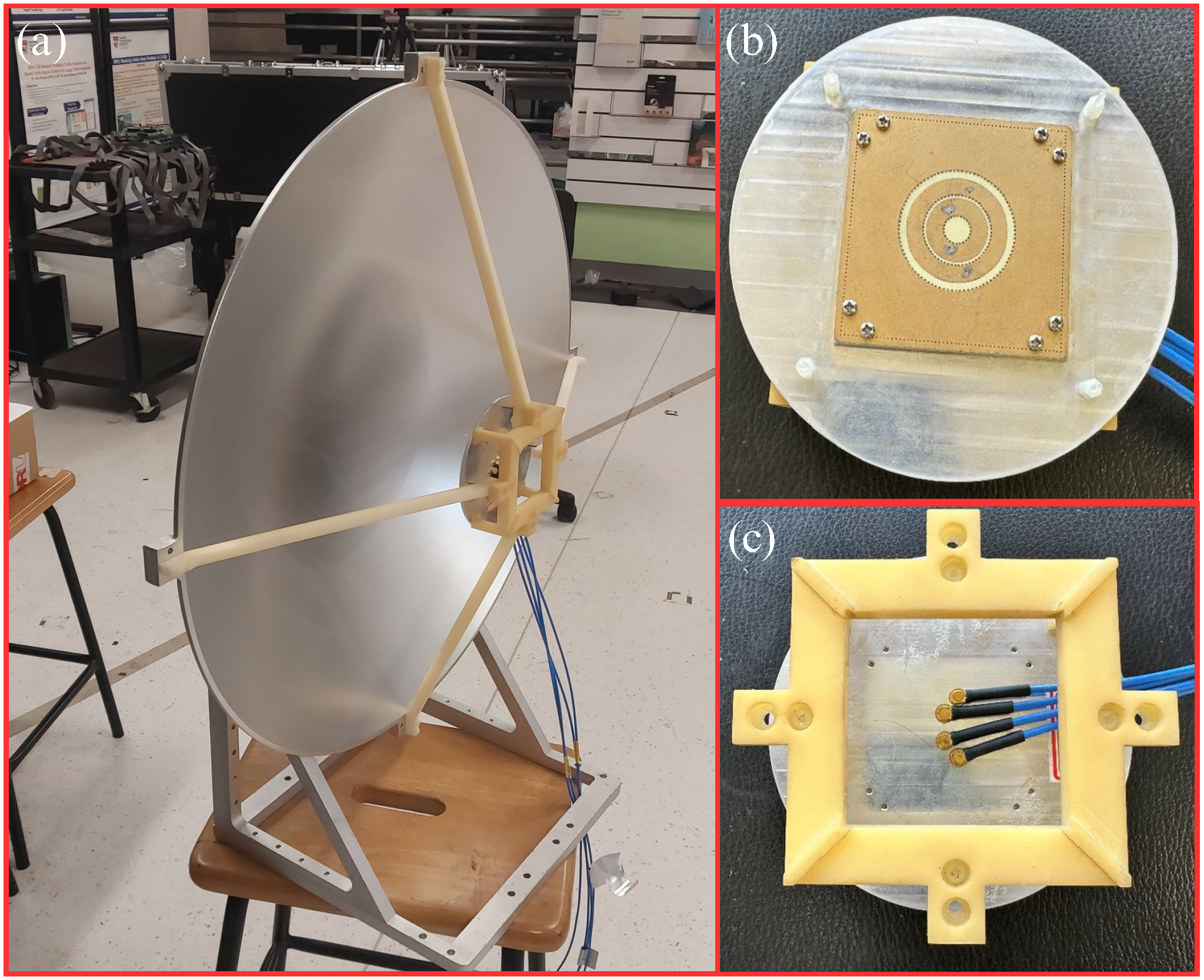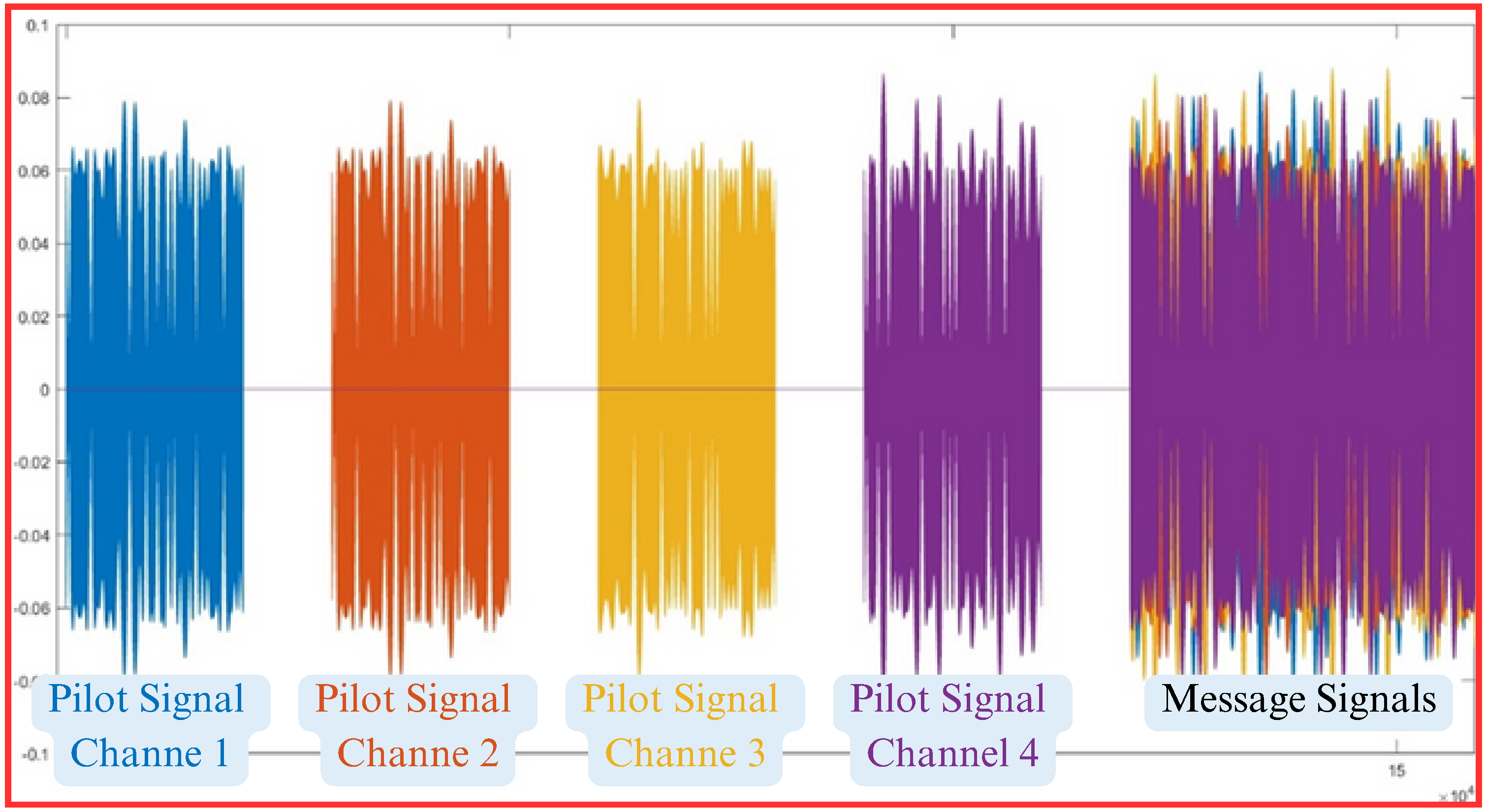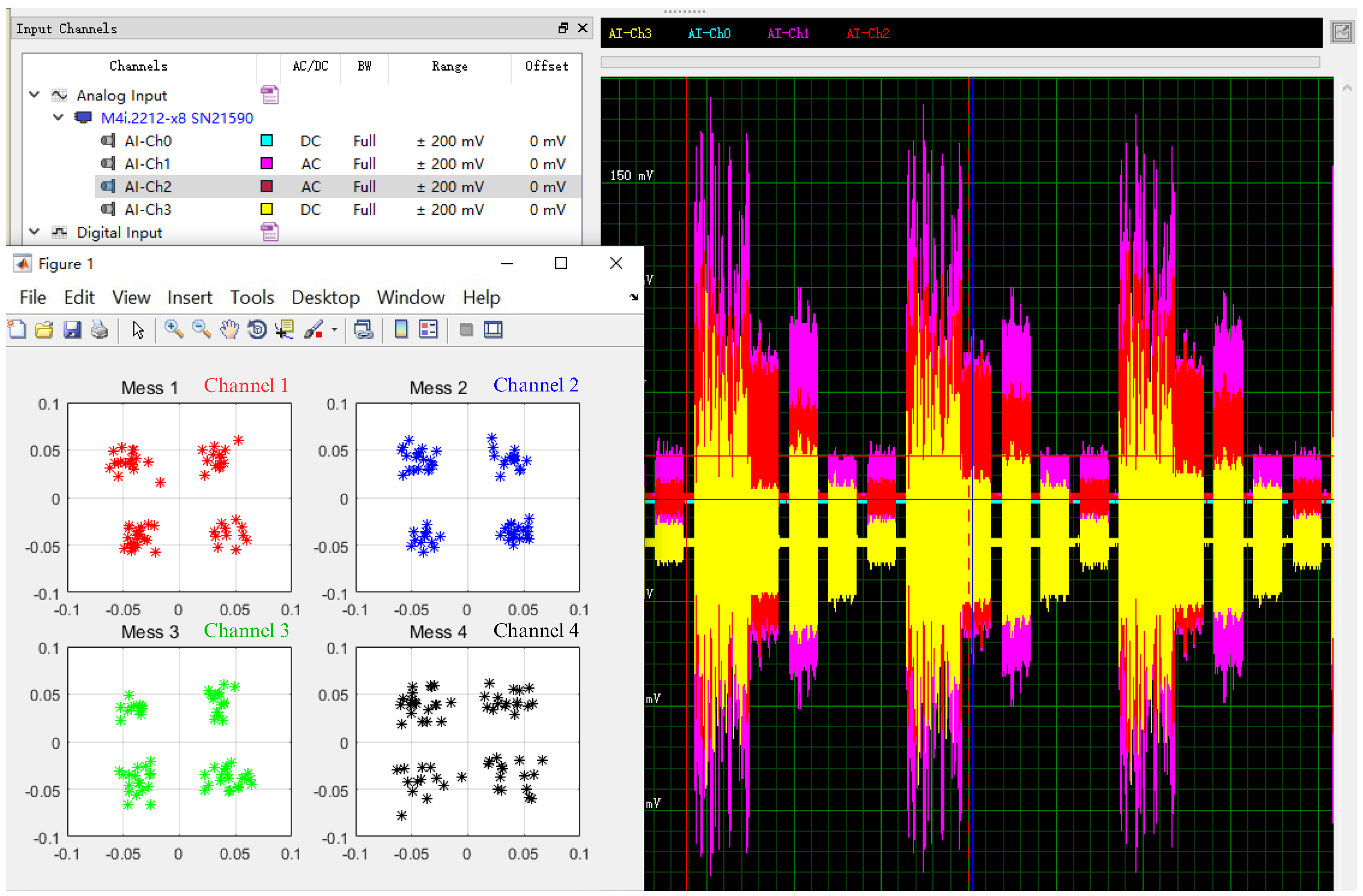A Multiple-Input Multiple-Output Transmission System Employing Orbital Angular Momentum Multiplexing for Wireless Backhaul Applications
Abstract
1. Introduction
2. System Architecture
2.1. OAM Reflector Antenna Design
2.2. Receiver Configuration Using Horn Antennas
3. Fabrication and Experiment
3.1. Transmitting Signal
3.2. Experimental Setups
3.3. Experiment Results and Discussion
4. Conclusions
Author Contributions
Funding
Acknowledgments
Conflicts of Interest
References
- Chia, S.; Gasparroni, M.; Brick, P. The next challenge for cellular networks: Backhaul. IEEE Microw. Mag. 2009, 10, 54–66. [Google Scholar] [CrossRef]
- Zhang, C.; Zhao, Y.; Zhang, Y.; Li, F.; Jiang, S. Position aided open-loop passive magnetic MIMO transmission. IET Commun. 2017, 11, 1449–1457. [Google Scholar] [CrossRef]
- Feng, X.; Zhao, Z.; Zhao, Y.; Zhao, Z.; Meng, L.; Guan, Y.L. OFDM-based waveform design for MIMO DFRC systems with reduced range sidelobes: A majorization-minimization approach. IEEE Trans. Veh. Technol. 2025, 74, 4582–4595. [Google Scholar] [CrossRef]
- Zhang, C.; Zhao, Y. High precision deep sea geomagnetic data sampling and recovery with three-dimensional compressive sensing. IEICE Trans. Fundam. 2017, E100-A, 1760–1762. [Google Scholar] [CrossRef]
- Bojic, D.; Sasaki, E.; Cvijetic, N.; Wang, T.; Kuno, J.; Lessmann, J.; Schmid, S.; Ishii, H.; Nakamura, S. Advanced wireless and optical technologies for small-cell mobile backhaul with dynamic software-defined management. IEEE Commun. Mag. 2013, 51, 86–93. [Google Scholar] [CrossRef]
- Luo, H.; Wang, J.; Lin, D.; Kong, L.; Zhao, Y.; Guan, Y.L. A novel energy-efficient approach based on clustering using gray prediction in WSNs for IoT infrastructures. IEEE Internet Things J. 2024, 11, 24748–24760. [Google Scholar] [CrossRef]
- Lin, D.; Wan, J.; Wang, J.; Kong, L.; Zhao, Y.; Guan, Y.L. A novel topology-scale-adaptive and energy-efficient clustering scheme for energy sustainable large-scale SWIPT-enabled WSNs. IEEE Trans. Mob. Comput. 2024, 23, 13172–13188. [Google Scholar] [CrossRef]
- Elmeadawy, S.; Shubair, R.M. 6G Wireless Communications: Future Technologies and Research Challenges. In Proceedings of the 2019 International Conference on Electrical and Computing Technologies and Applications (ICECTA), Ras Al Khaimah, United Arab Emirates, 19–21 November 2019; pp. 1–5. [Google Scholar]
- Zhang, C.; Zhao, Y.; Wu, H. High precision electromagnetic momentum positioning with current Loop. J. Magn. 2017, 22, 150–154. [Google Scholar] [CrossRef]
- Yang, Z.; Zhao, Y.; Ge, Y.; Fang, Y.; Guan, Y.L. Protograph-based LDPC-coded orbital angular momentum systems with index modulation. In Proceedings of the 2023 IEEE International Conference on Communications Workshops (ICC Workshops), Rome, Italy, 28 May–1 June 2023; pp. 11–16. [Google Scholar]
- Zhao, Y.; Guan, Y.L.; Yuen, C.; Liu, X.; Ismail, A.M.; Ge, Y. Advanced artificial Doppler shift manipulation with rotational vortex beams in space-time digital-coding RIS system: A practical approach. In Proceedings of the 2024 IEEE VTS Asia Pacific Wireless Communications Symposium (APWCS), Singapore, 21–23 August 2024; pp. 1–5. [Google Scholar]
- Allen, L.; Beijersbergen, M.W.; Spreeuw, R.J.C.; Woerdman, J.P. Orbital angular momentum of light and the transformation of Laguerre-Gaussian laser modes. Phys. Rev. A 1992, 45, 8185–8189. [Google Scholar] [CrossRef] [PubMed]
- Zhao, Y.; Ma, X.; Guan, Y.L.; Liu, Y.; Ismail, A.M.; Liu, X.; Yeo, S.Y.; Yuen, C. Near-orthogonal overlay communications in LoS channel enabled by novel OAM beams without central energy voids: An experimental study. IEEE Internet Things J. 2024, 11, 39697–39708. [Google Scholar] [CrossRef]
- Zhao, Y.; Feng, Y.; Ismail, A.M.; Wang, Z.; Guan, Y.L.; Guo, Y.; Yuen, C. 2-Bit RIS prototyping enhancing rapid-response space-time wavefront manipulation for wireless communication: Experimental studies. IEEE Open J. Commun. Soc. 2024, 5, 4885–4901. [Google Scholar] [CrossRef]
- Yang, Z.; Ge, Y.; Zhao, Y.; Fang, Y.; Guan, Y.L. Protograph LDPC code and shaped index modulation design for multi-mode OAM systems. IEEE Trans. Commun. 2024, 72, 5162–5178. [Google Scholar] [CrossRef]
- Zhao, Y.; Wang, Z.; Lu, Y.; Guan, Y.L. Multimode OAM convergent transmission with co-divergent angle tailored by Airy wavefront. IEEE Trans. Antennas Propag. 2023, 71, 5256–5265. [Google Scholar] [CrossRef]
- Chen, M.; Chen, R.; Zhao, Y.; Yang, Z.; Guan, Y.L. Index-modulation OAM detectors resistant to beam misalignment. IEEE Trans. Veh. Technol. 2024, 73, 2836–2841. [Google Scholar] [CrossRef]
- Zhao, Y.; Guan, Y.L.; Ismail, A.M.; Ju, G.; Lin, D.; Lu, Y.; Yuen, C. Holographic-inspired meta-surfaces exploiting vortex beams for low-interference multipair IoT communications: From theory to prototype. IEEE Internet Things J. 2024, 11, 12660–12675. [Google Scholar] [CrossRef]
- Zhu, Q.B.; Jiang, T.; Qu, D.M.; Chen, D.; Zhou, N.R. Radio vortex multiple-input multiple-output communication systems with high capacity. IEEE Access 2015, 3, 2456–2464. [Google Scholar] [CrossRef]
- Tamburini, F.; Mari, E.; Sponselli, A.; Thidé, B.; Bianchini, A.; Romanato, F. Encoding many channels on the same frequency through radio vorticity: First experimental test. New J. Phys. 2012, 14, 033001. [Google Scholar] [CrossRef]
- Tamburini, F.; Mari, E.; Parisi, G.; Spinello, F.; Oldoni, M.; Ravanelli, R.A.; Coassini, P.; Someda, C.G.; Thidé, B.; Romanato, F. Tripling the capacity of a point-to-point radio link by using electromagnetic vortices. Radio Sci. 2015, 50, 501–508. [Google Scholar] [CrossRef]
- Yan, Y.; Li, L.; Zhao, Z.; Xie, G.; Wang, Z.; Ren, Y.; Ahmed, N.; Sajuyigbe, S.; Talwar, S.; Tur, M.; et al. 32-Gbit/s 60-GHz millimeter-wave wireless communication using orbital angular momentum and polarization multiplexing. In Proceedings of the 2016 IEEE International Conference on Communications Workshops (ICC Workshops), Kuala Lumpur, Malaysia, 22–27 May 2016; pp. 1–6. [Google Scholar]
- Zhang, W.; Zheng, S.; Hui, X.; Dong, R.; Jin, X.; Chi, H.; Zhang, X. Mode Division Multiplexing Communication Using Microwave Orbital Angular Momentum: An Experimental Study. IEEE Trans. Wirel. Commun. 2017, 16, 1308–1318. [Google Scholar] [CrossRef]
- Gaffoglio, R.; Cagliero, A.; Vita, A.D.; Sacco, B. OAM multiple transmission using uniform circular arrays: Numerical modeling and experimental verification with two digital television signals. Radio Sci. 2016, 51, 645–658. [Google Scholar] [CrossRef]
- Zhao, Y.; Guan, Y.L.; Chen, D.; Ismail, A.M.; Ma, X.; Liu, X.; Yuen, C. Exploring RCS diversity with novel OAM beams without energy void: An experimental study. IEEE Trans. Veh. Technol. 2025, 74, 8321–8326. [Google Scholar] [CrossRef]
- Zhao, Y.; Zhang, C. Compound angular lens for radio orbital angular momentum coaxial separation and convergence. IEEE Antennas Wirel. Propag. Lett. 2019, 18, 2160–2164. [Google Scholar] [CrossRef]
- Zhao, Y.; Zhang, C. Orbital angular momentum beamforming for index modulation with partial arc reception. Electron. Lett. 2019, 55, 1271–1273. [Google Scholar] [CrossRef]
- Zhang, C.; Zhao, Y. Orbital angular momentum nondegenerate index mapping for long distance transmission. IEEE Trans. Wirel. Commun. 2019, 18, 5027–5036. [Google Scholar] [CrossRef]
- Yao, Y.; Liang, X.; Zhu, W.; Geng, J.; Jin, R. Experiments of Orbital Angular Momentum Phase Properties for Long-Distance Transmission. IEEE Access 2019, 7, 62689–62694. [Google Scholar] [CrossRef]
- Yagi, Y.; Sasaki, H.; Yamada, T.; Lee, D. 200 Gb/s Wireless Transmission Using Dual-Polarized OAM-MIMO Multiplexing with Uniform Circular Array on 28 GHz Band. IEEE Trans. Antennas Propag. 2021, 20, 833–837. [Google Scholar] [CrossRef]
- Yagi, Y.; Sasaki, H.; Lee, D. Prototyping of 40 GHz Band Orbital Angular Momentum Multiplexing System and Evaluation of Field Wireless Transmission Experiments. IEEE Access 2022, 10, 130040–130047. [Google Scholar] [CrossRef]
- Sasaki, H.; Yagi, Y.; Kudo, R.; Lee, D. 1.58 Tbps OAM Multiplexing Wireless Transmission with Wideband Butler Matrix for Sub-THz Band. IEEE J. Sel. Areas Commun. 2024, 42, 1613–1625. [Google Scholar] [CrossRef]
- Thidé, B.; Then, H.; Sjöholm, J.; Palmer, K.; Bergman, J.; Carozzi, T.D.; Istomin, Y.N.; Ibragimov, N.H.; Khamitova, R. Utilization of photon orbital angular momentum in the low-frequency radio domain. Phys. Rev. Lett. 2007, 99, 087701. [Google Scholar] [CrossRef] [PubMed]
- Mohammadi, S.M.; Daldorff, L.K.S.; Bergman, J.E.S.; Karlsson, R.L.; Thidé, B.; Forozesh, K.; Carozzi, T.D.; Isham, B. Orbital angular momentum in radio-A system study. IEEE Trans. Antennas Propag. 2010, 58, 565–572. [Google Scholar] [CrossRef]
- Zhao, Y.; Zhang, C. Distributed Antennas Scheme for Orbital Angular Momentum Long Distance Transmission. IEEE Antennas Wirel. Propag. Lett. 2020, 19, 332–336. [Google Scholar] [CrossRef]
- Yao, Y.; Liang, X.; Zhu, M.; Zhu, W.; Geng, J.; Jin, R. Analysis and experiments on reflection and refraction of orbital angular momentum waves. IEEE Trans. Antennas Propag. 2019, 67, 2085–2094. [Google Scholar] [CrossRef]
- Meng, Y.; Yi, J.; Nawaz, B.S.; Lei, K.; Zhang, H.; Werner, D.H. Phase-modulation based transmitarray convergence lens for vortex wave carrying orbital angular momentum. Opt. Express 2018, 26, 22019–22029. [Google Scholar] [CrossRef]
- Wu, Q.; Jiang, X.; Zhang, C. Attenuation of Orbital Angular Momentum Beam Transmission with Parabolic Antenna. IEEE Antennas Wirel. Propag. Lett. 2021, 20, 1849–1853. [Google Scholar] [CrossRef]
- Wu, Q.; Zhang, C. OAM backhaul link supporting 1 Tbps over 1 km transmission based on Cassegrain antenna. IEEE Trans. Wirel. Commun. 2025, 73, 4829–4839. [Google Scholar] [CrossRef]
- Zhang, C.; Jiang, J. Euclidean space with orbital angular momentum. In Proceedings of the 2019 IEEE International Conference on Communications Workshops (ICC Workshops), Shanghai, China, 20–24 May 2019; pp. 1–6. [Google Scholar]
- Zhang, C.; Jiang, X.; Zhao, Y. Efficient instantaneous channel propagation modeling for aeronautical communications systems with compressed sensing. IEEE Trans. Antennas Propag. 2022, 70, 1211–1220. [Google Scholar] [CrossRef]






| Researcher | Frequency | Mode No. | Distance | Rate |
|---|---|---|---|---|
| Tamburini F. [20] | 2.4 GHz | 2 | 442 m | n/a |
| Tamburini F. [21] | 17.128 GHz | 3 | 150 m | 33 Mbps |
| Yan Y. [22] | 60 GHz | 2 | 2.5 m | 32 Gbps |
| Zhang W. [23] | 10 GHz | 4 | 10 m | 300 Mbps |
| Gaffoglio R. [24] | 198.5 MHz | 2 | 40 m | 15.8 Mbps |
| Zhang C. [28] | 10 GHz | 2 | 27.5 km | 1 Mbps |
| Zhang C. [28] | 10 GHz | 2 | 172 km | 4 Mbps |
| Yao Y. [29] | 10 GHz | 2 | 3 km | n/a |
| Yagi Y. [30] | 28 GHz | 2 | 10 m | 200 Gbps |
| Yagi Y. [31] | 39.5–41 GHz | 2 | 100 m | 119 Gbps |
| Sasaki H. [32] | 136–168 GHz | 2 | 1 m | 1.58 Tbps |
| Wu Q. [39] | 40 GHz | 4 | 1 km | 1 Tbps |
| Our Work | 10 GHz | 4 | 100 m | NA |
| Parameter | Value |
|---|---|
| Carrier frequency | 10 GHz |
| Intermediate frequency | 100 MHz |
| Modulation scheme | QPSK |
| Transmission distance | Around 100 m |
| Transmitted power | 33 dBm |
| Signal bandwidth | 10 MHz |
| Configuration | Chn 1 | Chn 2 | Chn 3 | Chn 4 |
|---|---|---|---|---|
| OAM 4×4 (All On) | 0.00 () | 0.00 () | 0.0133 () | 0.0334 () |
| P-Wave 2×2 (Both On) | 0.4234 | 0.4426 | – | – |
| P-Wave (One Chn On) | 0.0114 | 0.4646 | – | – |
Disclaimer/Publisher’s Note: The statements, opinions and data contained in all publications are solely those of the individual author(s) and contributor(s) and not of MDPI and/or the editor(s). MDPI and/or the editor(s) disclaim responsibility for any injury to people or property resulting from any ideas, methods, instructions or products referred to in the content. |
© 2025 by the authors. Licensee MDPI, Basel, Switzerland. This article is an open access article distributed under the terms and conditions of the Creative Commons Attribution (CC BY) license (https://creativecommons.org/licenses/by/4.0/).
Share and Cite
Mohamed Ismail, A.; Zhao, Y.; Ju, G. A Multiple-Input Multiple-Output Transmission System Employing Orbital Angular Momentum Multiplexing for Wireless Backhaul Applications. Network 2025, 5, 33. https://doi.org/10.3390/network5030033
Mohamed Ismail A, Zhao Y, Ju G. A Multiple-Input Multiple-Output Transmission System Employing Orbital Angular Momentum Multiplexing for Wireless Backhaul Applications. Network. 2025; 5(3):33. https://doi.org/10.3390/network5030033
Chicago/Turabian StyleMohamed Ismail, Afkar, Yufei Zhao, and Gaohua Ju. 2025. "A Multiple-Input Multiple-Output Transmission System Employing Orbital Angular Momentum Multiplexing for Wireless Backhaul Applications" Network 5, no. 3: 33. https://doi.org/10.3390/network5030033
APA StyleMohamed Ismail, A., Zhao, Y., & Ju, G. (2025). A Multiple-Input Multiple-Output Transmission System Employing Orbital Angular Momentum Multiplexing for Wireless Backhaul Applications. Network, 5(3), 33. https://doi.org/10.3390/network5030033






